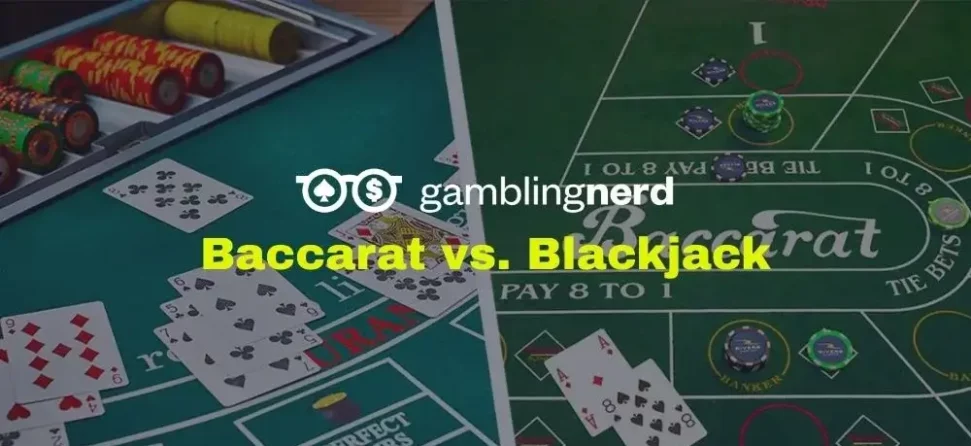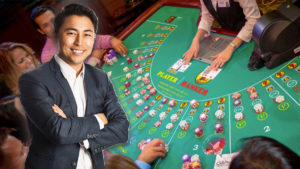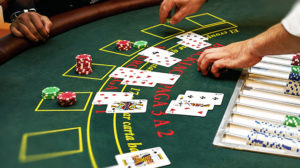Baccarat vs. Blackjack: Which Is More Profitable?

Baccarat and Blackjack share a feel but play in different gears. Blackjack invites you to make every decision, while Baccarat keeps things sleek and automatic.
I’ll compare the two games in plain English. Rules, pace, and decision points then lay out a clean odds snapshot (3:2 vs. 6:5 in blackjack, Banker/Player in baccarat).
You’ll get a clear side-by-side table and practical tips tied to risk tolerance and patience, ending with a direct call on which has better odds and which fits your style.
Blackjack vs. Baccarat Comparison (Overview + Table)
Both games compare totals, but the decision point separates them. In blackjack, you play your own hand against the dealer and choose to hit, stand, double, or split; those choices slow the pace and add skill.
In baccarat, you pick Banker, Player, or Tie before the deal, then fixed drawing rules take over and settle the hand, so rounds move faster with almost no input after the bet.
Baccarat Basics: Step-by-Step
Here’s the round from bet to payout. After you wager, fixed rules handle the draws. No extra choices.

- Goal: Pick the side Banker or Player that finishes closest to 9
- Place one bet: Banker, Player, or Tie.
- Deal two hands: two cards to Player and two to Banker (you don’t hold a personal hand).
- Card values: 2–9 = face value; 10/J/Q/K = 0; A = 1.
- Totals use modulo 10: only the last digit counts (e.g., 15 → 5).
- Naturals (8 or 9) on the first two cards end the hand; higher natural wins, equal is a Tie.
- Third-card rules are automatic: predefined rules decide if Player draws, then if Banker draws—no player input.
- Settle the bets: higher total wins; equal totals are a Tie (Banker/Player bets push).
- Payouts: Player 1:1; Banker 1:1 minus 5% commission. On commission-free/Super 6, a Banker 6 often pays 1:2, which slightly raises the Banker house edge. (Tie usually pays 8:1 or 9:1, table dependent.)
Blackjack Basics: Step-by-Step
You play your own hand against the dealer and choose how to act. Those choices affect pace and results.

- Goal: Beat the dealer without going over 21
- Place your bet; you receive two cards. The dealer takes two, with one face up.
- Card values: 2–10 = face value; J/Q/K = 10; A = 1 or 11.
- Your decisions: hit, stand, double down, split pairs; surrender may be offered at some tables.
- Dealer rules: draws until 17+; tables specify hit or stand on soft 17. Some games “peek” for blackjack when showing an Ace or 10.
- Blackjack (A + 10-value): pays 3:2 at good tables; some pay 6:5 (worse for players). A tied 21 is a push unless the dealer’s natural beats your non-natural 21.
- Busts and outcomes: if you bust, you lose immediately; if the dealer busts and you haven’t, you win. Otherwise, higher total wins; equal totals push.
- Variations matter: decks used, H17 vs. S17, doubling and splitting rules, surrender, and 3:2 vs. 6:5 payouts all change basic strategy and the house edge.
- Side bets: Insurance, 21+3, Perfect Pairs, and others exist but usually carry higher house edges.
Blackjack vs. Baccarat Quick Comparison
Here’s the no-fluff snapshot so you can compare the feel and the math side by side. Use it to spot where decisions happen, how fast each game moves, and what the typical edge looks like before you sit down.
| Element | Blackjack | Baccarat |
|---|---|---|
| Goal | Beat the dealer without going over 21; a two-card blackjack is best. | Bet on Banker or Player to finish closest to 9 (Tie is separate). |
| Decisions per hand | Multiple: hit, stand, double, split, surrender (if offered). | One upfront bet; all drawing is automatic. |
| Typical house edge | 0.5% with 3:2 and basic strategy; 1%–2%+ with 6:5 or mistakes. | Banker ~1.06%, Player ~1.24%; Tie ~14% at 8:1 (varies by paytable). |
| Pace | Moderate; choices slow the game (fewer hands per hour). | Fast; fixed rules resolve hands quickly (more hands per hour). |
| Side bets | Insurance, 21+3, Perfect Pairs usually have higher edges. | Pairs, Dragon/Bonus, Big/Small. Usually higher edges. |
| Card values | 2–10 face; J/Q/K = 10; A = 1 or 11. | 2–9 face value; 10/J/Q/K = 0; A = 1. |
| Skills involved | Learning basic strategy, recognizing table rules, and bankroll discipline | Bankroll discipline, table selection, and avoiding side bets. |
| Strategy involved | High. Correct play meaningfully lowers the edge. | Low. The edge is mostly set by your initial bet and table rules. |
Which Has Better Odds, Baccarat or Blackjack?
For most beginners, baccarat’s Banker bet has better odds out of the box (about 1.06% house edge). Blackjack odds can be better than that, but only if you play perfect basic strategy at a good 3:2 table with favorable rules; many casual players don’t.
Why it breaks this way: Baccarat’s edge is baked in—choose Banker and avoid side bets and you’re near optimal.
Blackjack’s edge swings with rules and your decisions. A solid 3:2, S17 game with basic strategy can land around 0.3%–0.5%; sit at 6:5 or misplay and you’re often 1%–2%+.
In baccarat, Player runs about 1.24%, Tie is usually bad (~14% at 8:1; ~4.8% at 9:1). On commission-free/Super 6 baccarat, Banker’s edge rises to about 1.46% because Banker 6 pays half.
For beginners, baccarat (Banker bet) is the most reliably low-cost play without study. Blackjack can be cheaper per hour than baccarat only if you find 3:2 rules and play solid basic strategy; with 6:5, it’s usually worse.
Rule of thumb: expected loss/hour ≈ average bet × house edge × hands/hour.
$10 examples:
- Baccarat (Banker): 1.06% × ~70 hands ≈ $7.42/hour
- Blackjack (3:2, basic): 0.5% × ~60 hands ≈ $3.00/hour
- Blackjack (6:5): 1.5% × ~60 hands ≈ $9.00/hour
Payouts and details that move the odds:
- Blackjack: 3:2 vs. 6:5 on blackjack, S17 vs. H17, number of decks, doubling/splitting limits, and surrender all shift the math—plus your accuracy on each hand.
- Baccarat: Commission (5%) vs. commission-free tables and the Tie paytable matter most; drawing rules are fixed, so there’s no in-hand strategy to misplay.
Is Baccarat Better Than Blackjack for Beginners?
If you want a low-maintenance start, baccarat is the better first stop: back Banker, skip side bets, and you’re playing near-optimal from hand one. If you prefer steering the action, choose sit a 3:2 blackjack table and follow a basic strategy chart.
Still unsure? My honest advice for beginners is to begin with baccarat to learn the flow, then try blackjack when you’re ready to trade speed for decision-making and a more hands-on feel.
Strategy Comparison: Blackjack vs. Baccarat
Blackjack is the more strategy-driven game because your choices and table rules materially change outcomes.
Blackjack basic strategy tells you when to hit, stand, double, split, or surrender based on your hand and the dealer’s upcard, and playing it well can shave the house edge to a sliver at good 3:2 tables.
The math is sensitive to rules S17 vs. H17, the number of decks, whether you can double after splits, and surrender options; all matter.
Mistakes compound quickly, and most side bets (insurance, 21+3, Perfect Pairs) carry noticeably higher edges, so I treat them as entertainment only.
If you want a game you can actively learn and improve at, pick blackjack
On the other hand, Baccarat rewards discipline but not in-hand skill.
This game is about bet-selection, not hand play. Once you choose Banker or Player, fixed third-card rules take over, so there’s almost nothing to “optimize” mid-hand.
Your best “strategy” is table selection (standard commission vs. Super 6), steady bankroll management, and skipping side bets like Pairs or Dragon that spike the house edge.
If you prefer set-it-and-go simplicity, pick baccarat.
Blackjack vs. Baccarat: Which Game Is Easier?
For most newcomers who want a quick, correct play with minimal study, baccarat is the easier start. The learning curve is lighter. One upfront bet, fixed drawing rules, and almost no terminology to memorize. You’ll feel “correct” on hand one.
Blackjack asks more: reading the dealer’s upcard, following a basic strategy chart, and avoiding errors that quickly add cost. Decision load and mistake sensitivity make blackjack more demanding, and it takes longer to reach confident play.
Pace and bankroll tell a second story. Baccarat deals more hands per hour, so even with a low edge your bankroll can cycle faster. So discipline matters.
Blackjack’s slower rhythm can stretch a session, but beginner pitfalls (6:5 tables, misplays, side bets) can outweigh the pace advantage.
Access is easy online for both; in live dealer casinos, baccarat tables sometimes carry higher minimums.
FAQs
Can you count cards in baccarat (or should you)?
Anonymous, September 17, 2025

Answer
Taylor Smith , September 18, 2025
Not really, card tracking in baccarat barely moves the odds and never flips them in your favor.
Why is 6:5 blackjack worse than 3:2?
Anonymous, September 17, 2025

Answer
Isaac Payne , September 18, 2025
A 6:5 table pays less, which adds roughly a percentage point or more to the house edge versus a 3:2 table. Always hunt for 3:2.
Conclusion
Baccarat is simpler with a steady, low house edge on the Banker bet. Blackjack can match or beat it only with 3:2 rules and solid basic strategy; side bets in both games raise the edge.
For beginners choosing between Baccarat vs. Blackjack, Banker offers the best odds out of the box, while Blackjack shines if you want control, can follow a basic chart, and prefer a slower, more tactical pace.
Pick the game that fits your style, start with low limits, seek standard-commission baccarat or 3:2 blackjack, set a session budget and time box, and test a few short sessions to confirm the fit.
Find an online casino to start playing blackjack or baccarat today!



